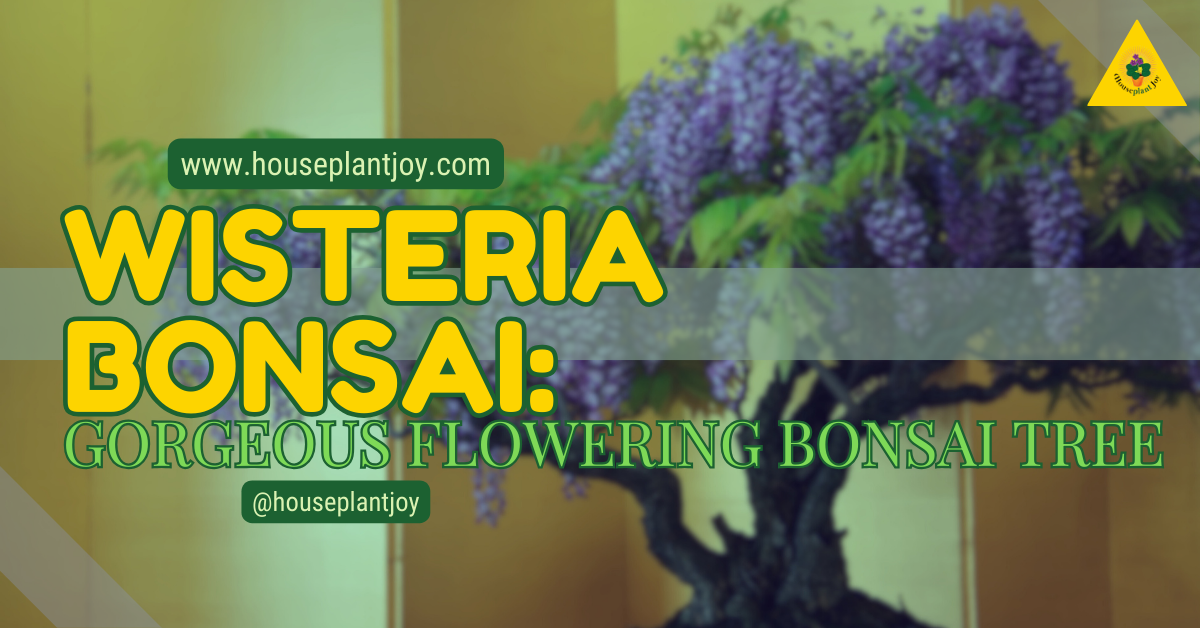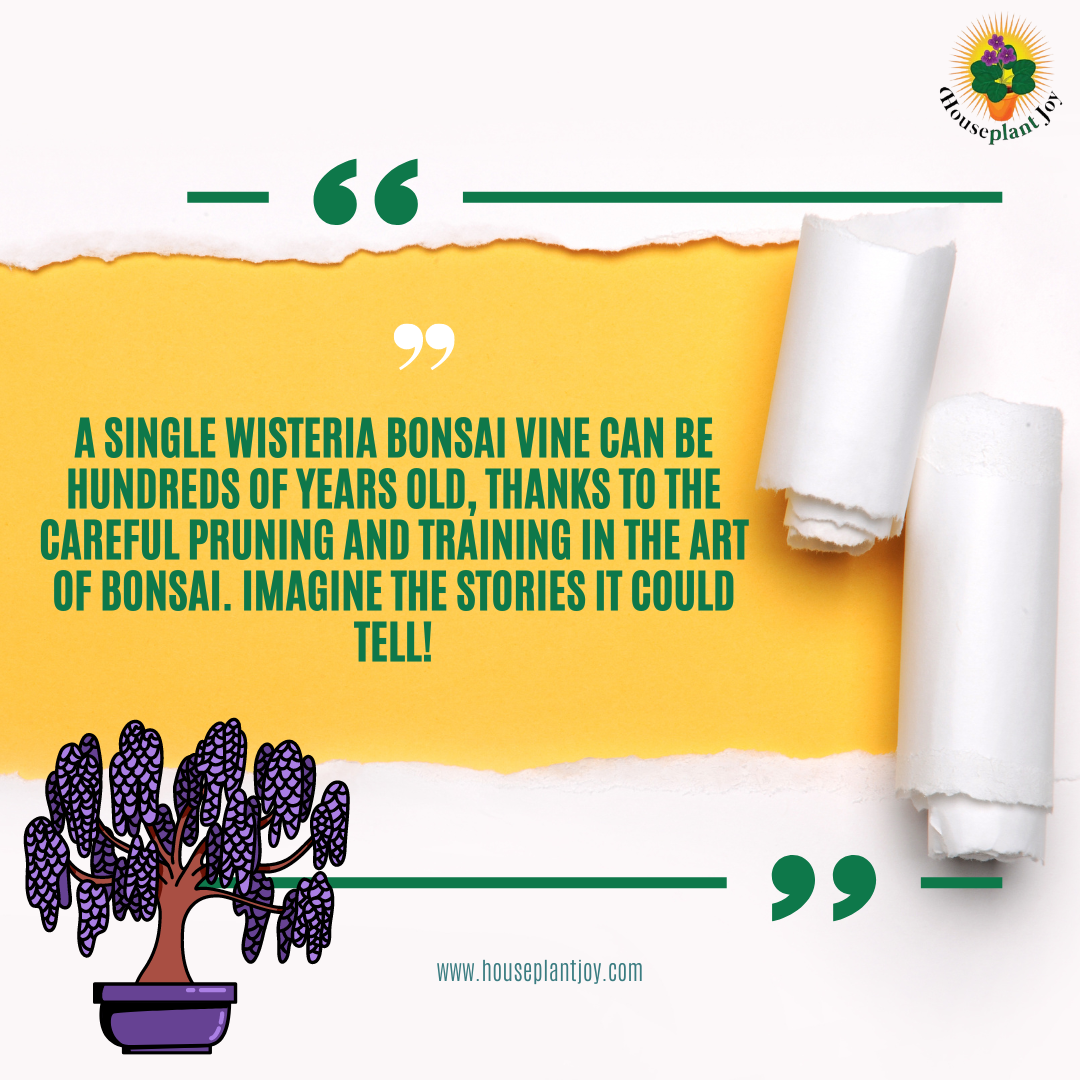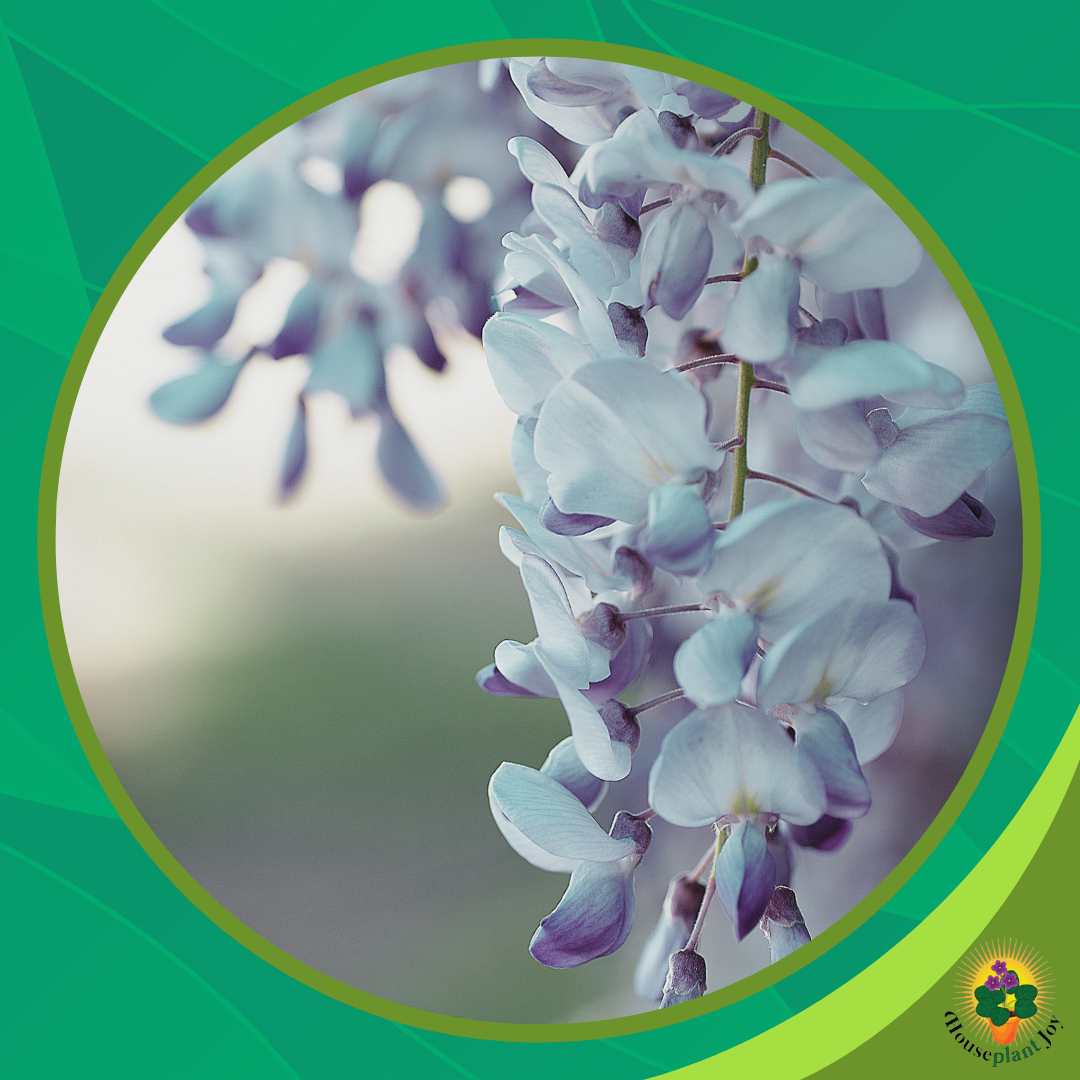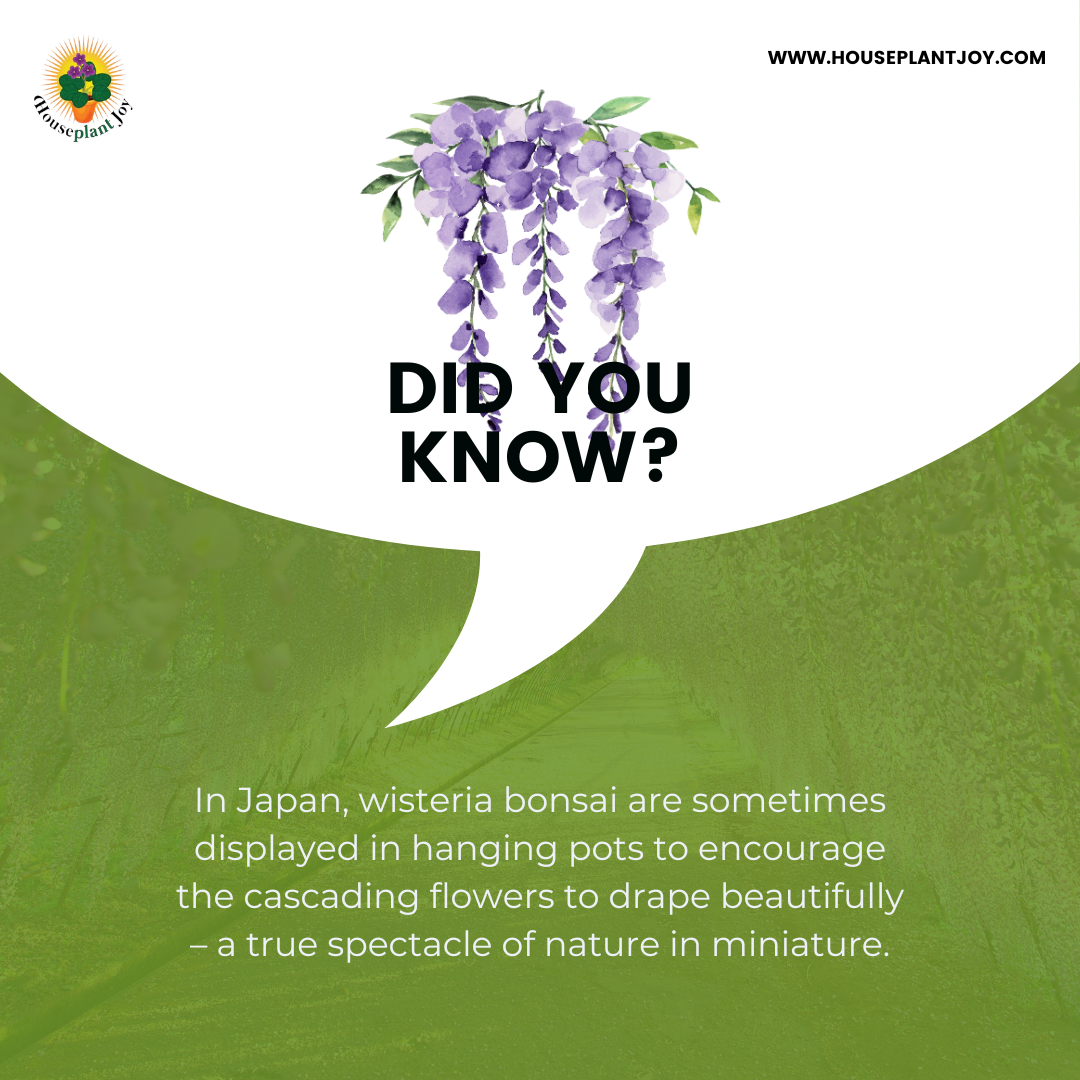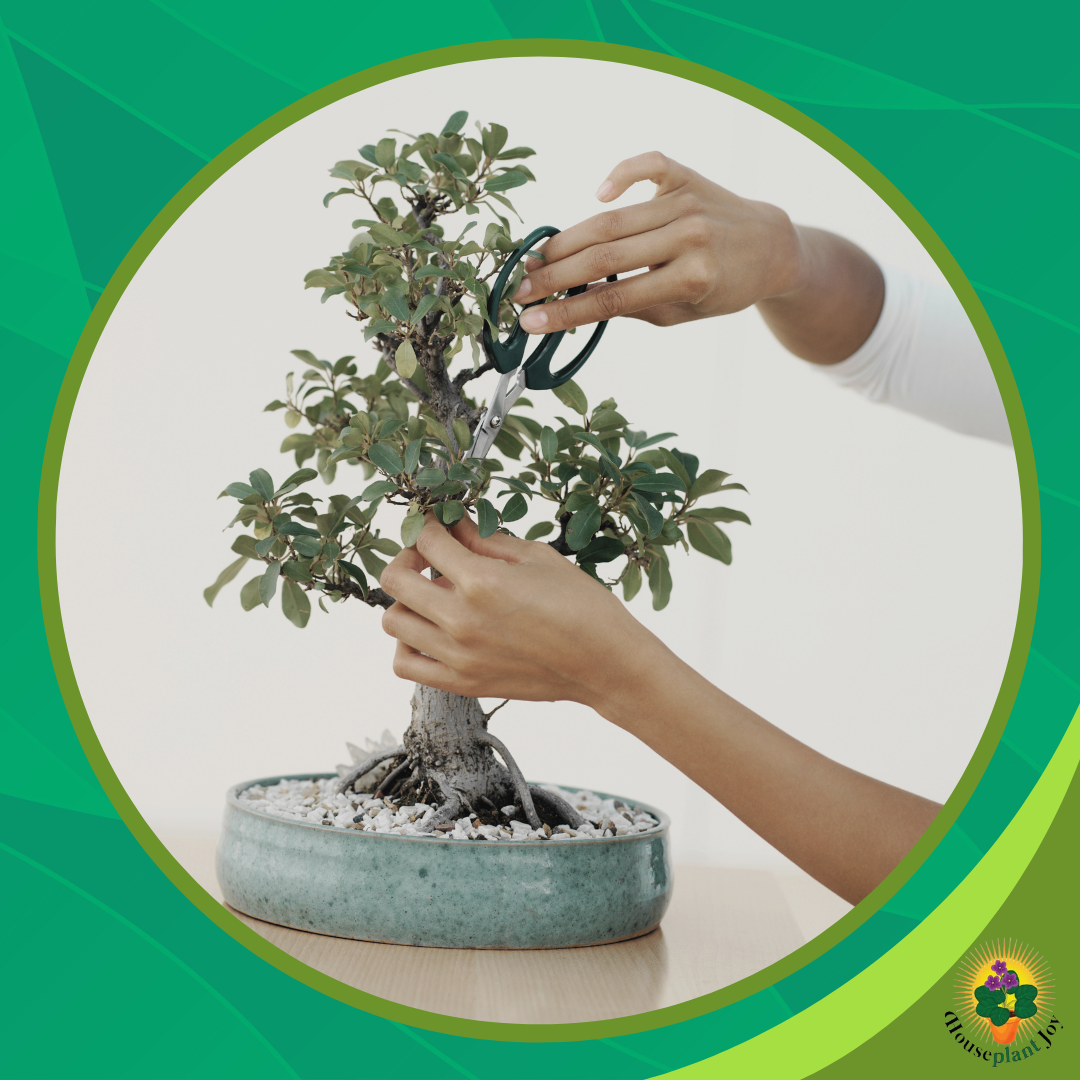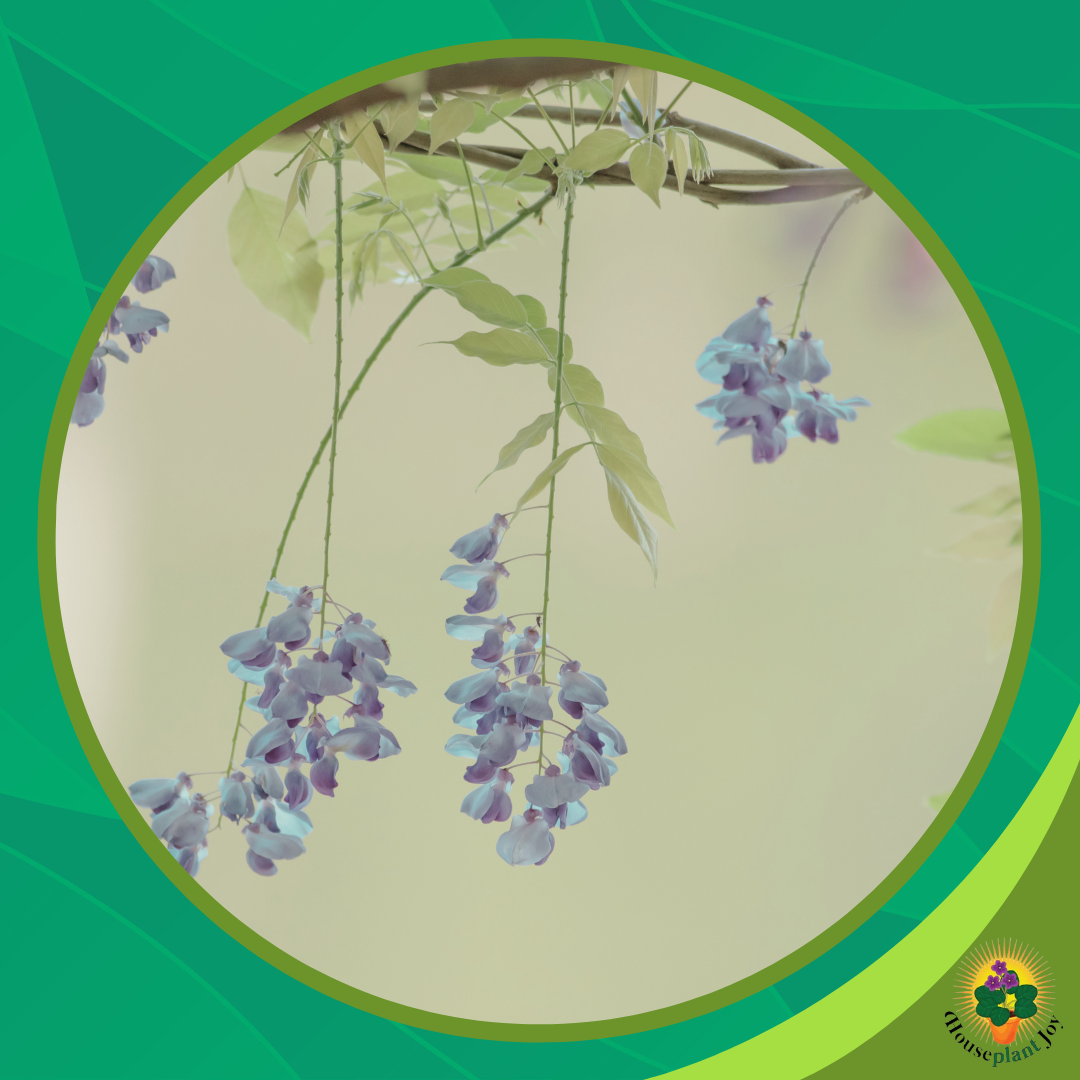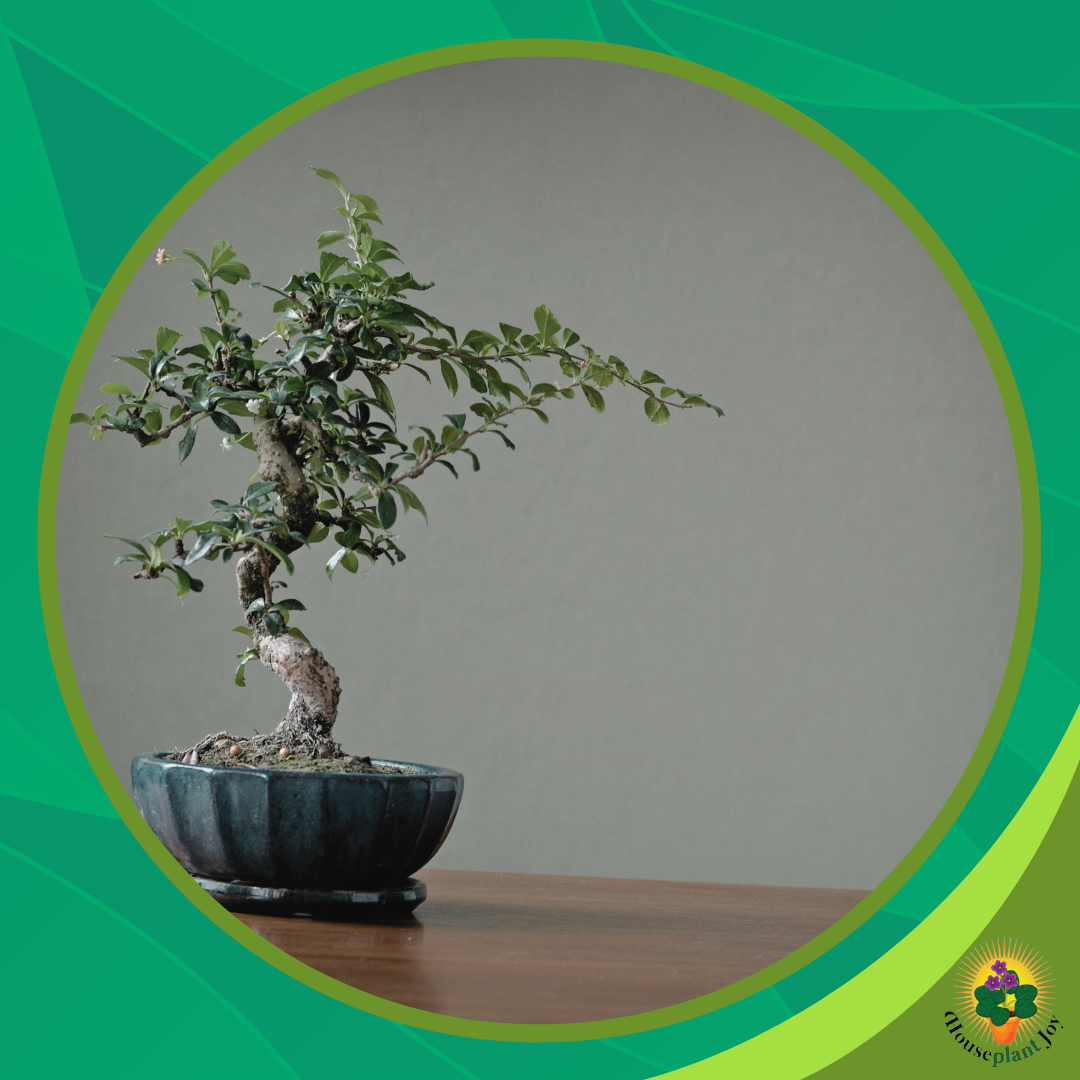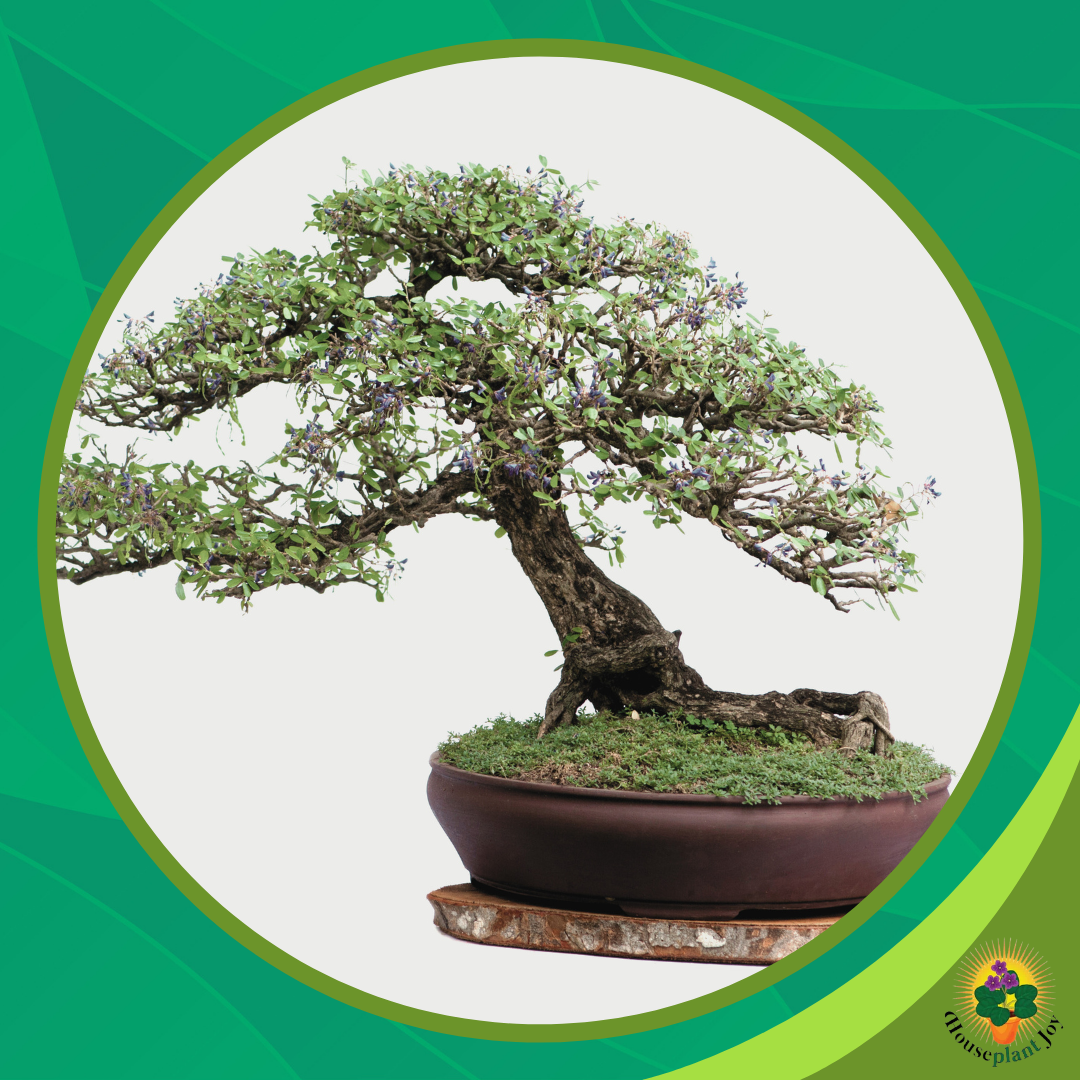HousePlantJoy is supported by our audience. When you purchase through one of our links, we may earn a small affiliate commission. As an Amazon Associate I earn from qualifying purchases. Your cost is not affected.
==================
Wisteria Bonsai: The art of bonsai is a captivating journey that transforms ordinary trees into extraordinary, miniature works of art. Bonsai enthusiasts adore the Wisteria bonsai for its beautiful, fragrant, purple blooms that cascade gracefully. If you have been gardening for ages and have wanted to explore more, why not try cultivating your bonsai? May this guide inspire you to embrace the challenge, though; yes, it may be a little tricky and require more patience, but trust me, the result will be worth it!
Wisteria Bonsai: Gorgeous Flowering Bonsai Tree Care Tips
When it comes to bonsai trees, the Wisteria bonsai stands out as one of the most gorgeous flowering varieties. Its striking flowers and unique shape make it a sought-after addition to any bonsai collection. Whether you are a seasoned bonsai enthusiast or just starting, the Wisteria bonsai offers a rewarding experience.
I remember the first time I saw a Wisteria bonsai in full bloom. The vibrant purple and white flowers hung gracefully, creating a breathtaking display. This tree is not only beautiful but also a symbol of patience and care. Growing one requires specific techniques, but the results are worth every effort. Imagine your Wisteria bonsai as the centrepiece of your garden, drawing attention with its elegance and charm. Growing and maintaining this tree can be a fulfilling hobby that brings both relaxation and a sense of achievement.
With this guide, we will explore the enchanting world of Wisteria bonsai, offering insights into its history, cultivation techniques, and the profound beauty it brings to any space. We will also tackle some tips and tricks to help your Wisteria bonsai thrive.
Key Takeaways
- Wisteria bonsai is known for its gorgeous flowers and unique form.
- Growing one requires specific care and techniques.
- A blooming Wisteria bonsai can be the stunning focal point of any garden.
Understanding Bonsai
Bonsai is an ancient art form that transforms ordinary trees into captivating miniatures. These small trees capture the grandeur of nature in a compact form.
The Origin and History of Bonsai
Originated in China over a thousand years ago, Bonsai art was called “Penjing” and focused on creating miniature landscapes. Monks and scholars practised Penjing as a spiritual and artistic discipline. This art spreads in Japan in the 12th century. The Japanese refined the techniques and aesthetics, making bonsai a method to symbolize harmony between man and nature. It represents patience, care, and balance.
Today, bonsai is famous worldwide. People are drawn to its beauty and the meditative process of caring for these tiny trees. Famous historical bonsai, some over centuries old, are displayed in museums.
What Makes a Bonsai a Bonsai?
A bonsai is more than a small tree; it’s a living art piece. The key elements are shape, proportion, and root care. The goal is to create a natural look on a miniature scale. Pruning and wiring help shape the tree. It’s not just about making it tiny but capturing the essence of a full-sized tree. Roots are regularly trimmed to keep the tree healthy and in proportion. The choice of pot is crucial and should complement the tree, not overshadow it. Soil mix, usually well-draining, helps maintain the right balance of nutrients and moisture. Bonsai care requires attention to detail, patience, and a deep appreciation for nature.
Specifics of Wisteria Bonsai
Wisteria bonsai trees have unique characteristics that make them popular in bonsai art. They are known for their stunning flowers and need specific care to thrive.
Characteristics of Wisteria
This beautiful tree is known for its long, cascading clusters of blue, lavender, or white flowers, which appear early in spring and create a striking visual impact. The leaves are pinnate and typically grow in clusters of about 13-19 leaflets, making the foliage lush and vibrant. The bark is smooth in young trees but develops a more rugged texture as the tree matures, adding to its aesthetic appeal.
Wisteria grows rapidly, which requires regular pruning to maintain its shape and size. These trees are deciduous, shedding their leaves in winter. Healthy flowering requires full sun during the growing season.
Why Wisteria is Prized in Bonsai
The Wisteria is highly valued in bonsai due to its beautiful and fragrant flowers. Its blooms have a cascading habit that looks spectacular in a bonsai pot, resembling miniature waterfalls of blossoms. The tree’s ability to adapt to pruning also makes it ideal for bonsai enthusiasts. With proper care, wisteria bonsai can produce abundant flowers, showcasing their beauty year after year.
Additionally, the contrast between the tree’s rugged bark and delicate flowers adds a unique charm. This balance of visual elements emphasizes the artistry involved in bonsai cultivation. Wisteria’s resilience to pruning allows for creative shaping, letting bonsai artists experiment with different styles and designs.
Cultivating Your Wisteria Bonsai
Growing a wisteria bonsai requires careful selection, proper potting techniques, and attention to soil and fertilization. Let’s dive into the specifics to ensure your tree thrives and blossoms beautifully.
Selecting Your Wisteria
When choosing a wisteria for bonsai, I look for healthy plants with vibrant green leaves and a strong root system. It is available in several varieties, but Japanese Wisteria is the most popular for bonsai. This variety has stunning flowers that cascade gracefully. I also consider the age and size of the plant. Younger plants may take longer to flower, so selecting a more mature wisteria can give me quicker results. Always inspect the plant for any signs of disease or pests before deciding.
Potting and Repotting Essentials
Getting the right pot and knowing how to repot is crucial. I use a shallow bonsai pot with adequate drainage holes covered by fine mesh to prevent soil from escaping. This setup ensures proper water drainage, which is vital for the health of my Wisteria.
When repotting, I remove dead roots and trim excess ones to fit the plant into the bonsai pot. Repotting is typically done every 2-3 years in early spring before new growth starts. Using binding wire helps secure the tree, preventing it from shifting and damaging its roots.
Soil and Fertilization Needs
Soil quality is essential for wisteria bonsai. I use a well-draining soil mix containing components like lava rock, pumice, and akadama. This mix allows for good aeration and moisture retention without becoming waterlogged.
Fertilization supports healthy growth and flowering. I apply a balanced, slow-release fertilizer monthly during the growing season. I prefer organic fertilizers, which provide steady nutrients without harming the plant. Wisteria requires more phosphorus to boost flowering, so a phosphorus-rich fertilizer, especially in early spring, is beneficial.
Regularly checking and maintaining soil moisture is also vital. Wisteria likes moist but not soggy soil. I water well and check daily, particularly in hot, dry weather. Proper soil and fertilization practices keep my wisteria bonsai healthy and beautiful.
Training and Pruning
To create a beautiful wisteria bonsai, you need to focus on proper training and pruning. This involves using specific techniques to shape and keep your tree healthy by trimming and wiring it carefully.
Basic Training Techniques
When starting, I make sure to remove all dead roots and trim the healthy ones to fit into the bonsai pot. For the best results, ensure the plant gets plenty of sunlight during the growing season. Using mesh over the watering holes helps keep the soil from being washed away. Adding phosphorous and potassium-rich fertilizer while minimizing nitrogen helps promote flower bud development.
Pruning: Timing and Techniques
For maintaining the shape and health of a wisteria bonsai, pruning is crucial. I start by pruning back the leaves if they grow too dense. This ensures sunlight reaches the inner parts of the tree. I recommend pruning leaves back to four if you have dense foliage. The best time to prune is in early spring before new growth starts. Regular pruning helps encourage many flowers and keeps the plant balanced and neat.
Wiring Techniques and Care
In shaping your wisteria bonsai into beautiful forms, wiring is the key. I use binding wire, usually about ten inches long, and carefully wrap it around the branches. This helps guide the branches as they grow. Also, ensure the wire is not wrapped too tightly to avoid damaging the plant. Regularly checking and adjusting the wires as the branches grow are essential to prevent scarring.
Maintenance and Care
Maintaining a Wisteria Bonsai requires attention to watering, pest management, and winter care. Creating the right environment for your bonsai to thrive and produce beautiful flowers is essential.
Watering Your Bonsai
Proper watering is essential for a Wisteria Bonsai as it thrives on ample moisture.I keep the soil consistently damp, especially during the growing season and water it daily in the summer, sometimes twice if it’s scorching. I avoid letting the soil dry out completely. However, I also ensure the pot has good drainage to prevent root rot. Using a watering can with a delicate rose helps to water gently without disturbing the soil.
Dealing With Pests and Diseases
Pests and diseases can be a nuisance for Wisteria Bonsai. I look for aphids, spider mites, and caterpillars. When I see pests, I spray them with water or use insecticidal soap. Fungal diseases can also affect the bonsai. To this end, I ensure good air circulation around the plant. Removing fallen leaves promptly also helps prevent fungal growth. Copper-based fungicides work well for treating any infections that appear.
Winter Care for Wisteria Bonsai
For Wisteria Bonsai, winter care is essential. Since they are frost-hardy in the ground but the roots in pots are vulnerable, I move mine to a frost-free location. A cold greenhouse, garage, or shed works perfectly. I reduce watering in the winter to keep the soil barely moist. This helps to avoid root rot during colder months. Additionally, I occasionally check for pests, even in winter, as they can sometimes surprise you.
Wisteria Bonsai Aesthetics
Wisteria bonsai trees are admired for their stunning flowers and lush greenery. Critical factors like flowering patterns, leaf pruning, and pot selection are crucial in enhancing their beauty.
Flowering Patterns and Displays
The hallmark of Wisteria Bonsai is its cascading flowers, which come in shades of purple, pink, and white, creating a vibrant and enchanting display. Flower clusters form in early spring and can last up to a few weeks. To ensure strong blooms, the bonsai needs full sunlight, especially during the growing season.
Feeding the bonsai with fertilizer rich in phosphorus and potassium while reducing nitrogen helps support flower development. Maintaining the right temperature range between 68°F to 77°F (20°C to 25°C) is also crucial for producing abundant and vibrant flowers.
Leaf Pruning for Optimal Display
Pruning is essential in bonsai care. For Wisteria, this means selective trimming of leaves to highlight their flowers. Reducing excessive foliage allows more light to reach the plant, encouraging better flower growth.
It also helps maintain the tree’s shape and ensures that the energy is concentrated on flowering rather than leaf production. Regular pruning should be done during the growing season. I recommend using sharp, clean tools to make precise cuts. This will promote healthy regrowth and reduce the risk of disease.
The Significance of Pot Selection
Choosing the right pot is more than just aesthetics; it impacts the health and display of the wisteria bonsai. The pot must have proper drainage to prevent waterlogging, as wisteria roots are sensitive. Ensuring the pot is proportionate to the tree helps maintain stability and visual harmony.
Aesthetically, selecting a pot that complements the flower colors can enhance the overall look. For example, a deep blue pot can make purple flowers appear even more vivid. Ensuring the pot matches the style and needs of the bonsai is vital for both health and beauty.
Showcasing Your Wisteria Bonsai
Presentation is key when exhibiting or photographing your wisteria bonsai. Learning techniques for displaying and capturing your bonsai can make a big difference.
Bonsai Exhibition Tips
When setting up your wisteria bonsai for an exhibition, I pay close attention to its presentation. Placing the bonsai in a high-quality pot enhances its appearance. Choosing a pot that complements the tree’s color and style can make it stand out even more. I always ensure the bonsai is healthy and in peak condition.
Regularly pruning and cleaning the tree helps it look its best. Arranging it with good lighting can highlight its unique features and beautiful flowers, making it a striking centerpiece in any exhibit. Another tip is to consider the background. I use a plain, neutral background to avoid distracting from the bonsai’s beauty. Simple props like small stones or moss can add a natural touch without taking away from the tree.
Photographing Your Bonsai for Sharing
When I photograph my wisteria bonsai, lighting is crucial. Natural sunlight brings out the vibrant colors of the flowers and leaves. Positioning the bonsai so the light hits it from the side can create interesting shadows and depth. I like to use a clean, uncluttered background to make the bonsai stand out in the photo. A plain wall or a piece of fabric works well.
Taking close-up shots of the flowers and branches can capture the intricate details. A tripod helps keep the camera steady, especially in low-light conditions. I often experiment with angles, photographing from different heights and positions. This lets me see which angle shows off my bonsai’s best features. Sharing these photos on social media allows others to appreciate the beauty of the wisteria bonsai, too.
Advanced Techniques
Advanced techniques like grafting and layering can enhance your Wisteria bonsai’s growth and appearance. These methods can help you create new varieties and propagate your plants effectively.
Grafting for Improved Varieties
Grafting involves joining two plants to grow as one. I use this method to combine the best features of different Wisteria species. First, you need a healthy rootstock and a scion (the shoot you want to graft). Cut both at an angle and join them tightly. Secure them with grafting tape. After a few weeks, the two parts should fuse together.
Grafting can improve flower color, size, and even growth rate. It’s also a valuable technique for repairing damaged plants or incorporating disease-resistant traits.
Layering for Propagation
Layering is another advanced technique where a branch is made to produce roots while still attached to the parent plant. This is very effective for propagating Wisteria bonsai. Select a healthy branch and make a small cut to expose the inner tissue. Apply rooting hormone to this area and wrap it with moist sphagnum moss. Cover it with plastic wrap to retain moisture. Roots will develop after several weeks. Once a sufficient root system is established, cut the branch from the parent and plant it separately. Layering helps ensure that the new plant retains the characteristics of the parent, making it a reliable method for propagation.
Community and Resources
Connecting with other bonsai enthusiasts and using various learning materials can significantly enhance your experience with wisteria bonsai. Engaging with communities and resources provides valuable insights and support.
Joining Bonsai Clubs and Societies
Joining local or online bonsai clubs and societies is a great way to learn from others and share your passion. Clubs often host workshops where experienced members teach pruning, wiring, and other techniques. In-person meetings offer hands-on learning opportunities, while online groups provide a platform to ask questions and share photos. Some popular online forums and social media groups focus specifically on Wisteria Bonsai and have active members who are always willing to help.
Books and Online Resources
Many books and websites are available to deepen your knowledge of wisteria bonsai care. You can find detailed care guides explaining everything from using the correct fertiliser to maintaining the right temperature for flower development. Websites like Bonsai Empire and Bonsai Station offer specific advice on wisteria bonsai. Additionally, investing in a few key books by bonsai experts can provide a solid foundation and serve as reference guides throughout your bonsai journey.
Wisteria Bonsai: Capturing Nature’s Cascading Beauty
Cultivating a Wisteria bonsai is a rewarding journey that blends artistry with horticultural skill. The cascading blooms of Wisteria, meticulously shaped and cared for, bring a touch of natural elegance to any bonsai collection.
From understanding its unique pruning needs to appreciating its seasonal bloom cycles, nurturing a Wisteria bonsai requires patience and dedication. Yet, the sight of its abundant, fragrant flowers cascading like miniature waterfalls is a testament to the beauty and tranquillity that bonsai cultivation can bring.
Given all the tips and guides, we hope that this will be the beginning of embarking on the enchanted world of Bonsai cultivation. We wish you success in your bonsai journey and hope it brings you into the serene and beautiful world of bonsai art. Happy planting!
Frequently Asked Questions
Caring for a Wisteria bonsai involves sunlight, pruning, and proper feeding. These trees can grow both indoors and outdoors, but there are some specifics you need to know.
How do you care for a Wisteria bonsai tree?
What size do Wisteria bonsai trees typically reach?
Can Wisteria bonsai trees be grown indoors?
How long does it take for a Wisteria bonsai to bloom?
Where can I buy a Wisteria bonsai tree?
Are You Ready to Jumpstart Your Bonsai Journey?
Follow us on our social media channels and let’s share helpful tips for nurturing green, thriving plants together!

